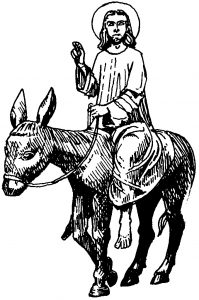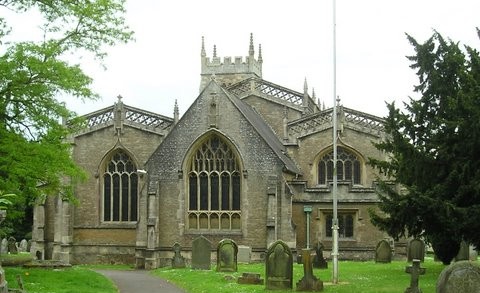Link to the reflection video for Palm Sunday – https://youtu.be/F_wwbfGQafU
Link the Passion gospel for Holy Week – https://youtu.be/ByK06Kob8H4
Psalm 118:1-2, 19-end, Isaiah 50:4-9, Mark 11:1-11
In the name of the living God, God the Father, God the Son and God the Holy Spirit, Amen
It is a real rarity to just have the story of Jesus riding into Jerusalem on a colt as the main topic on Palm Sunday – we would normally also hear the whole passion story. We can’t do that in person this year as it would stretch the time we are together well beyond the recommended limits. To engage with that story at our own pace this Holy Week, there is a video of the Passion Gospel available with some prayers and a couple of our favourite passiontide hymns. It also features a number of readers from both Pen Selwood and Wincanton. (The link is in the newsletter for this week). If we can’t engage with the video I strongly urge us to engage with the story by reading Mark’s gospel (chapters 14 and 15) in their entirety during this coming week, and as we do it dwell in the story in prayer and reflection.
 But for now let’s unpack the story of Jesus entry into Jerusalem on the first Palm Sunday. The story starts with Jesus and his disciples travelling and then gathering at the Mount of Olives – where he also prayed the night after the last supper before he was arrested by the authorities. As is often the case this starting point on the Mount of Olives is also a link to prophecy – in Zechariah 14:4 is says – On that day his feet shall stand on the Mount of Olives, which lies before Jerusalem on the east; of the coming Messiah.
But for now let’s unpack the story of Jesus entry into Jerusalem on the first Palm Sunday. The story starts with Jesus and his disciples travelling and then gathering at the Mount of Olives – where he also prayed the night after the last supper before he was arrested by the authorities. As is often the case this starting point on the Mount of Olives is also a link to prophecy – in Zechariah 14:4 is says – On that day his feet shall stand on the Mount of Olives, which lies before Jerusalem on the east; of the coming Messiah.
This whole account resonates with holy texts and religious practice of the day – particularly the kind of festival celebrated as part of the feast of tabernacles. That included the use of Psalm 118 – part of which we also said this morning being used, alongside a procession involving the waving of palm branches.
The kind of procession described also brought to mind the rituals surrounding the anointing of a new king. In the early part of the story told in the first book of Kings, the dying King David had asked that his son Solomon be allowed to ride on a colt to Gihon, where he was anointed prior to being made King (after David’s death and after a brief power struggle). Importantly and resonantly on the long ride to Gihon there was a long rejoicing procession behind Solomon (even though this prefigured the death of a King, in this instance David).
The whole way this story is told is also pointing to a prophecy in Zechariah chapter 9. In other gospels this verse is quoted in the gospel account – Verse 9 says Rejoice greatly, O daughter Zion! Shout aloud, O daughter Jerusalem! Lo, your king comes to you; triumphant and victorious is he, humble and riding on a donkey, on a colt, the foal of a donkey. In Mark’s gospel, which we know is often exceptionally brief and terse in style – the level of detail in this story is all there to make deeper points about the importance of Jesus and what was happening…
Let’s turn next to what the crowd were shouting – Hosanna means save now and the first clause after the Hosanna – Blessed is he who comes in the name of the Lord is a reference to where psalm 118 goes beyond the verses we said together. The next couple of verses say
25 Save us, we beseech you, O Lord! O Lord, we beseech you, give us success!
26 Blessed is the one who comes in the name of the Lord. We bless you from the house of the Lord. 27 The Lord is God, and he has given us light. Bind the festal procession with branches,
All of that points to where Jesus has come from and who he is, and the traditions the crowds are leaning into at this point. We know how it is (though frankly it has been a while for most of us!) to be caught up in a crowd. In its own way the enthusiasm of the crowd gathered also probably sealed Jesus fate with the religious authorities.
The next statement from the crowd Blessed is the coming kingdom of our father David! is trying to link the words of the crowd with their history more implicitly. There are a lot of complicated theories about this, but I think this is about the strands of thought prevalent about the messiah, and the need in the moment to give Jesus status and credibility as successor to David and recognise his kingship. At the time there was a lot of tendency to talk about Abraham, Isaac, Jacob, Moses and David harking back.
The final part of the chant – Hosanna in the highest as Hosanna means save now, Hosanna in the highest more literally means God save him. This is ultimately what God did do but not without the cost to Jesus of the first Good Friday that opened up the heart of God’s love to us all.
In the links back to the beginning of Luke’s account of Jesus life, it was also important that Jesus entered the temple at the end. This relates to the backdrop the one who came in the name of the Lord, was to enter the temple and give thanks for their deliverance but also was the one expected. Expected for their redemption and to saved them from their current peril. Anna spoke of the 40-day old Jesus, as for the redemption of Jerusalem, which he was (but not in the way they expected or wanted)
There is a lot going on in this story, when we dig beneath the surface a bit. In our #LiveLent material we have also been asked to dig beneath the stories of films, TV shows and other aspects of our culture to see how to make links to God’s story in our conversations. We were asked to address four important questions during this past week:-
-
Who are we?
-
What is wrong?
-
What is the solution?
-
What is the future?
Hannah Steele also addresses these questions in the accompanying book – which I summarise.
-
Who are we? – We are made in the image of God, capable of loving and being loved, of doing good and looking after our beautiful world.
-
What is wrong? – We and all humankind are also capable of great wrongdoing and of perpetuating injustice to put our own needs first in the place of God’s love for us
-
What is the solution? God intervened in the world by sending his only Son. In Christ God takes on human flesh and walks about among us. His life, death and resurrection are the means by which our relationship with God is restored.
-
What is the future? Jesus speaks of offering us abundant life that starts now and lasts for ever. We live in his kingdom guided by the Holy Spirit to share the good news.
In short, these questions help us to make deeper connections with our culture and ways into conversations. In a different way we have been using some of them to help us understand the story of Jesus’ entry into Jerusalem more deeply in the culture of his day (particularly who are we and what is the future). As this week unfolds and we enter once again into these rich holy mysteries, let’s spend some time thanking God for his love for us and our faith in God.
Hannah Steele in a conversation with a chatty taxi driver summed up her faith thus. There are lots of reasons why I am a Christian, but the most important is that I am irresistibly draw to the person of Jesus. I am drawn by who he was, the things he said and did and the fact that he rose from the dead. That’s why I am a follower of Jesus. How would we sum up our faith and how we would answer the questions – Who are we, what is wrong, what is the solution and what is the future. Think on, reflect on and pray on. Amen
New Revised Standard Version Bible: Anglicised Edition, copyright © 1989, 1995, #LiveLent God’s Story, Our Story – Stephen Hance
(Church House Publishing) Living His Story – Hannah Steele (SPCK), Prayer from www.rootsontheweb.
